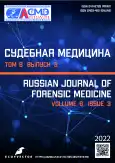根据多排螺旋CT扫描数据确定颅脑创伤的机制:一个专家实践的案例
- 作者: Li Y.B.1,2, Vishniakova M.V.1, Klevno V.A.1
-
隶属关系:
- Moscow Regional Research and Clinical Institute
- Primorsky Regional Bureau of Forensic Medical Examination
- 期: 卷 8, 编号 3 (2022)
- 页面: 85-92
- 栏目: 临床病例报告
- URL: https://journals.rcsi.science/2411-8729/article/view/122475
- DOI: https://doi.org/10.17816/fm736
- ID: 122475
如何引用文章
全文:
详细
在日常实践中,法医师解决准确确定伤害机制的问题,也是为了正确地着重刑事调查或初步检查的重点,以确定每个涉案人员的罪责。 每个嫌疑人在犯罪中的“贡献”有多大,相应地决定了对犯罪的责任有多大。在只有一个人涉嫌伤害他人身体的情况下,对于侦查机关来说,同样重要的是确定受害者哪些伤害是由该人直接造成的,而哪些只是在特定时间点上的各种情势的不幸的凑合。在这种情况下,对伤害机制问题的明确回答往往能使调查人员根据现行的《俄罗斯联邦刑事法》对嫌疑人的行为进行充分的评定。当涉及到对受害者、被告和其他人(活人)的鉴定时,情况变得复杂,因为与检查尸体相比,法医师没有机会详细检查 “原生材料”,而只限于医疗记录的数据、实验室和仪器测试的结果以及对被鉴定人的检查,这些通常是在事件发生很久之后由侦查机关提供的。
与标准放射照相相比,大脑多排螺旋CT的结果作为一种更准确的诊断方法,再加上对所提供案例材料的研究,使得在严重颅脑创伤的情况下可以逐次确定,总共形成颅脑创伤的 综合损伤,完全是由于撞击坚硬的钝物而跌倒造成的,从而限定了对撞击和反撞击区域的损害。
对该专家案例的分析证实了在法医学中使用现代放射诊断方法的重要性,特别是在确定颅脑损伤的机制方面。上述专家实践的案例证明了研究准确的放射诊断方法(在本案例中是多排螺旋CT)的结果和侦查机关提供的案例材料以确定颅脑创伤机制的重要性,特别是在对受害者、被告和其他人的鉴定中,这一点非常重要。
关键词
作者简介
Yulia B. Li
Moscow Regional Research and Clinical Institute; Primorsky Regional Bureau of Forensic Medical Examination
编辑信件的主要联系方式.
Email: reineerdeluft@gmail.com
ORCID iD: 0000-0001-7870-5746
Graduate Student correspondence
俄罗斯联邦, Moscow; VladivostokMarina V. Vishniakova
Moscow Regional Research and Clinical Institute
Email: cherridra@mail.ru
ORCID iD: 0000-0003-3838-636X
SPIN 代码: 1137-2991
MD, Dr. Sci. (Med.)
俄罗斯联邦, MoscowVladimir A. Klevno
Moscow Regional Research and Clinical Institute
Email: vladimir.klevno@yandex.ru
ORCID iD: 0000-0001-5693-4054
SPIN 代码: 2015-6548
MD, Dr. Sci. (Med.), Professor
俄罗斯联邦, Moscow参考
- Gromov AP, Naumenko VG. Forensic traumatology. Moscow: Meditsina; 1976. 368 р. (In Russ).
- Topography of force stresses in bones during trauma. Atlas. Ed. by V.N. Kryukov. Barnaul, Altaiskoe knizhnoe izdatel’stvo; 1977. 176 р. (In Russ).
- Kryukov VN. Fundamentals of mechanical and morphogenesis of fractures. Moscow: Folium; 1995. 232 р. (In Russ).
- Popov VL. Traumatic brain injury: Forensic aspects. Leningrad: Meditsina; 1988. 240 p. (In Russ).
- Popov VL. Non-fatal traumatic brain injury. Saint Petersburg: Yuridicheskii tsentr; 2020. 112 р. (In Russ).
- Diagnosticum of mechanisms and morphology of fractures in blunt trauma of the skeleton. Ed. by V.N. Kryukov. 2nd edition, reprint. Novosibirsk: Nauka; 2011. 522 p. (In Russ).
- Klevno VA, Kislov MA. Morphological signs of fractures of flat and long tubular bones in cases of impact and compression. Russian Journal of Forensic Medicine. 2015;1(2):100–101. (In Russ).
- Fetisov VA, Smirenin SA, Khabova ZS. The specific features of a lethal injury to the driver and the passenger of a scooter resulting from the collision with a car moving in the same direction. Sudebno-meditsinskaya ekspertiza. 2014;57(5):12-14. (In Russ).
- Ulyankin VE, Kupriyanov AY, Zyubina EA, Machinsky PA. Formation of a closed craniocerebral injury by an indirect mechanism: a case from expert practice. Russian Journal of Forensic Medicine. 2021;7(3):168–171. (In Russ). doi: 10.17816/fm380
- Likhterman LB. Classification of traumatic brain injury. Part II. Modern principles of traumatic brain injury classification. Russian Journal of Forensic Medicine. 2015;1(3):37–48. (In Russ).
- Forensic medical examination of traumatic brain injury: reference materials. Kursk; 2014. 73 p. (In Russ).
- Focal brain injury. Clinical recommendations (approved by the Ministry of Health of the Russian Federation). Association of Neurosurgeons of Russia; 2022. 82 p. (In Russ).
- Klevno VA. Problems of forensic medical examination of living persons in modern criminal proceedings. In: Topical issues of forensic medical examination of victims, suspects, accused and other persons: abstracts of reports of the All-Russian Scientific and Practical Conference, Ryazan, March 15-16. Moscow-Ryazan: Russian State Medical University named after Academician I.P. Pavlov Roszdrav; Russian Center of Forensic Medical Examination Roszdrav; 2007. Р. 3−8. (In Russ).
- Kildyushov EM, Egorova EV, Kuzin AN, Zhulidov AA. Diagnostic capabilities of computed tomography in forensic medical examination of traumatic brain injury. Sudebno-meditsinskaya ekspertiza. 2018;61(4):19–23. (In Russ). doi: 10.17116/sudmed201861419
补充文件












